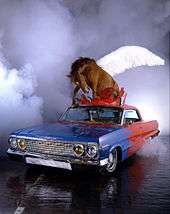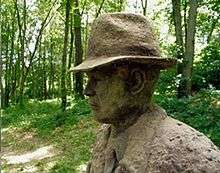James Croak
James Croak (born 1951) is a visual artist known for his work in conceptual figuration and sculpture.
James Croak | |
|---|---|
| Born | 1951 (age 68–69) |
| Nationality | American |
| Education | University of Illinois[1] |
| Known for | conceptual configuration and sculpture |
Early years
James Croak was born in Cleveland, Ohio in 1951. His mother died at the age of two.[1] At the age of 15 he was a recognized musical prodigy and studied under Andrés Segovia, the virtuoso Spanish classical guitarist.[1] At the age of sixteen he gave a series of concerts as a part of the 1968 Summer Olympic Games in Mexico City.[1] Following his high school education, Croak attended the Ecumenical Institute in Chicago studying philosophy,[2] and studied sculpture concurrently at the University of Illinois at Chicago graduating in 1974.[2]
Professional life



Croak received a National Endowment for the Arts artist-in-residence grant in 1976. At this point much of his work was done with the medium of aluminum in a method similar to that of Frank Stella, although Croak is believed to have developed his personal technique himself.[2] Later that year he moved his work to the abandoned Fire Station Number 23 in Los Angeles, California, where his work became less abstract and more figural.[2] After eight years he moved to Brooklyn, New York.[2]
Croak's work was featured in Thomas C. McEvilley's book Sculpture in the Age of Doubt, and also in a book dedicated entirely to Croak's work entitled James Croak, published by the same author. In 2011 he was featured at the Wellcome Collection in London, UK as a part of an exhibition entitled "Dirt".[3] The work exhibited was designed to cause a strong emotional reaction in the onlooker: a review of his work at this show by The Guardian newspaper's art critic Laura Cumming stated that, "It would be hard to overstate the physical effect of James Croak's… sculpture".[3] The sculpture was an example of his "dirt sculpture" technique, which employs a mixture of binder and different kinds of dirt, dust, and soil.[1] According to the artist, the material was developed out of necessity, stating that in 1985, "I wanted to cast a full-size self–portrait, but I couldn't afford bronze, so I walked down the street to an empty lot, dug up dirt, put it in a wheelbarrow, took it home, mixed it with glue, and pressed it into the plaster mold."[4] He has also been known to work with found objects[5] and taxidermy.[6] A twenty-year retrospective of his work was held in 1998 at the Contemporary Art Center of Virginia.[7]
The transition from aluminum to dirt as a medium gave his work a harder and rougher feel than his prior works.[1] In each medium Croak has designed his works in a series. Some examples of his series include the Dirt Man series, the Dirt Baby series, and the Dirt Window series.[1] Croak is also a published writer, with essays appearing in the books This Will Make You Smarter: New Scientific Concepts to Improve Your Thinking and Is the Internet Changing the Way you Think?: The Net's Impact on our Minds and Future, both edited by John Brockman. An additional essay was published in the book Afterwords, a compilation put together by Salon.com featuring the works of its contributors, which Croak has been one on occasion.[8] He is also an online contributor and conference participant to the non-profit intellectual organization Edge.org,[9] the membership of which is composed of highly accomplished thinkers in both the arts and sciences from different corners of the world.[9][10] His works are also available at the website Artnet.[11] According to art critic Carlos Suarez de Jesus, themes involved in Croak's work often include death, social instability, and the finite nature of human life.[12] Another recurring theme in his work is ancient mythology.[13] In addition, James Croak is an avid pilot and has an American commercial pilot license.
Dirt sculpture
Croak's dirt sculpture technique goes as follows. First a model is selected and photographed from many different angles. The photograph is then dressed with a grid in order to allow for accurate size referencing.[14] Second, an armature is created from steel and aluminum that is strong enough to support two hundred pounds of clay.[15] Third, the clay is sculpted in the presence of the model over the span of more than one hundred hours in order to replicate the model's body as precisely as possible.[16] Fourth, smaller and more minute details like the face are refined.[17] Fifth, the sculpture is then cut into pieces and a two layer mold (a rubber layer and a plaster layer) is made from those pieces.[18] Sixth, Croak digs up or acquires a large amount of dirt and dries it with the aid of large fans.[19] Seventh, Croak mixes the dirt with a binder, then pours the mixture into the mold.[20] Eighth, once set, the pieces of the sculpture are then reassembled and glued together with the same dirt and binder mixture with which they were created.[21] His dirt sculptures have appeared in over twenty-five published books.[22]
References
- "James Croak interview with Barbara Bloemik, Curatorial Director of the National Design Museum at the Smithsonian". Smithsonian. Archived from the original on 4 February 2012. Retrieved 17 January 2012.
- "Dirty Work". The Pitch. Archived from the original on 2 April 2015. Retrieved 17 January 2012.
- Cumming, Laura (27 March 2011). "Dirt: The Filthy Reality of Everyday Life—Review". The Guardian. London. Retrieved 18 January 2012.
- Edith Newhall (October 29, 2001). "Down to Earth". New York Magazine.
- Vincent Katz (September 1994). "James Croak Stux Gallery". Artnews.
- Leslie Wolf (November 18, 1983). "Review". LA Weekly.
- Catherine Dorsey (December 15, 1998). "The Dirty Business of Art". Port Folio Weekly.
- Croak, James (19 September 2001). "The Dig". Salon.com. Retrieved 17 January 2012.
- "Biography". Edge.org. Retrieved 17 January 2012.
- "A Show of Hands". New York Times. May 1999.
- "Artist Profile". Retrieved 17 January 2012.
- Carlos Suarez de Jesus (January 5, 2006). "The Large and the Small of It". New Times.
- Colin Gardner (November 1983). "Revising the Archetype". Artweek.
- "Dirt Sculpture Process". Archived from the original on 5 February 2012. Retrieved 17 January 2012.
- "Dirt Sculpture Process". Archived from the original on 20 August 2011. Retrieved 17 January 2012.
- "Dirt Sculpture Process". Archived from the original on 27 December 2008. Retrieved 17 January 2012.
- "Dirt Sculpture Process". Archived from the original on 4 March 2016. Retrieved 17 January 2012.
- "Dirt Sculpture Process". Archived from the original on 4 March 2016. Retrieved 17 January 2012.
- "Dirt Sculpture Process". Archived from the original on 4 March 2016. Retrieved 17 January 2012.
- "Dirt Sculpture Process". Archived from the original on 4 March 2016. Retrieved 17 January 2012.
- "Dirt Sculpture Process". Archived from the original on 4 March 2016. Retrieved 17 January 2012.
- "James Croak". Archived from the original on 18 January 2012. Retrieved 4 February 2012.